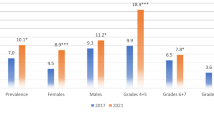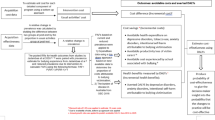Abstract
Being a victim of bullying is linked to various social, emotional and behavioral problems potentially leading to a reduced quality of life. Furthermore, victims of bullying may cause extensive costs for society, for example by an above-average need for healthcare services. The present study was designed to quantify the costs and the loss of quality of life attributable to bullying by comparing victims with a control group of non-bullied students. A cross-sectional sample of 1293 adolescents (mean age 14.07, SD = 1.36) and their parents reported on bullying victimization, quality of life (adolescents’ self-report), and annual direct (medical and non-medical) as well as indirect costs (parents’ self-report) from a societal perspective (all expressed in €, year 2014 and 2015). For frequent (20.6% of our sample; costs: €8461.80 p.a.) but not occasional (13.3%; costs: €2850.06) bullying, victimization was associated with significantly higher costs compared to non-bullied adolescents (costs: €3138.00; annual difference between frequently bullied students and controls: €5323.01 p.a.; p = 0.008). Cost drivers included increased direct medical costs, but mostly indirect costs caused by productivity losses of the parents. Self-reported quality of life of frequent victims was considerably reduced (T = − 10.96; p < 0.001); also occasional bullying showed significantly reduced values in global quality of life (T = − 5.73; p < 0.001). The present findings demonstrate that frequent bullying is associated with substantial cost to society and reduced quality of life of victims. This observation underscores the need for effective school-based bullying prevention and suggests a high potential of effective programs to be cost effective as well.

Similar content being viewed by others
References
Olweus D (1994) Annotation: bullying at school: Basic facts and effects of a school based intervention program. Child Psychol Psychiatry Allied Discip 35:1171–1190. https://doi.org/10.1111/j.1469-7610.1994.tb01229.x
Olweus D (2012) Cyberbullying: an overrated phenomenon? Eur J Dev Psychol 9:520–538. https://doi.org/10.1080/17405629.2012.682358
Craig W, Harel-Fisch Y, Fogel-Grinvald H et al (2009) A cross-national profile of bullying and victimization among adolescents in 40 countries. Int J Public Health 54(Suppl 2):216–224. https://doi.org/10.1007/s00038-009-5413-9
Gini G, Pozzoli T (2009) Association between bullying and psychosomatic problems: a meta-analysis. Pediatrics 123:1059–1065. https://doi.org/10.1542/peds.2008-1215
Nakamoto J, Schwartz D (2010) Is peer victimization associated with academic achievement? A meta-analytic review. Soc Dev 19:221–242. https://doi.org/10.1111/j.1467-9507.2009.00539.x
Bond L, Carlin JB, Thomas L et al (2001) Does bullying cause emotional problems? A prospective study of young teenagers. BMJ 323:480–484. https://doi.org/10.1136/bmj.323.7311.480
Barker ED, Arseneault L, Brendgen M et al (2008) Joint development of bullying and victimization in adolescence: relations to delinquency and self-harm. J Am Acad Child Adolesc Psychiatry 47:1030–1038. https://doi.org/10.1097/CHI.0b013e31817eec98
Jantzer V, Haffner J, Parzer P et al (2015) Does parental monitoring moderate the relationship between bullying and adolescent nonsuicidal self-injury and suicidal behavior? A community-based self-report study of adolescents in Germany. BMC Public Health 15:583. https://doi.org/10.1186/s12889-015-1940-x
Klomek AB, Sourander A, Gould M (2010) The association of suicide and bullying in childhood to young adulthood: a review of cross-sectional and longitudinal research findings. Can J Psychiatry Rev Can Psychiatr 55:282–288
Copeland WE, Wolke D, Angold A, Costello EJ (2013) Adult psychiatric outcomes of bullying and being bullied by peers in childhood and adolescence. JAMA Psychiatry 70:419–426. https://doi.org/10.1001/jamapsychiatry.2013.504
Arseneault L, Milne BJ, Taylor A et al (2008) Being bullied as an environmentally mediated contributing factor to children’s internalizing problems: a study of twins discordant for victimization. Arch Pediatr Adolesc Med 162:145–150
Silberg JL, Copeland W, Linker J et al (2016) Psychiatric outcomes of bullying victimization: a study of discordant monozygotic twins. Psychol Med 46:1875–1883. https://doi.org/10.1017/S0033291716000362
Takizawa R, Maughan B, Arseneault L (2014) Adult health outcomes of childhood bullying victimization: evidence from a five-decade longitudinal British birth cohort. Am J Psychiatry 171:777–784. https://doi.org/10.1176/appi.ajp.2014.13101401
Rupp A, Gause EM, Regier DA (1998) Research policy implications of cost-of-illness studies for mental disorders. Br J Psychiatry 173(Suppl 36):19–25
Pelham WE, Foster EM, Robb JA (2007) The economic impact of attention-deficit/hyperactivity disorder in children and adolescents. J Pediatr Psychol 32:711–727. https://doi.org/10.1093/jpepsy/jsm022
Gold MR, Siegel JE, Russell LB (1996) Cost-effectiveness in health and medicine. Oxford University Press, New York
Kumpulainen K, Räsänen E, Puura K (2001) Psychiatric disorders and the use of mental health services among children involved in bullying. Aggress Behav 27:102–110
Fosse GK (2006) Mental health of psychiatric outpatients bullied in childhood. Dissertation, Department of Neuroscience, Faculty of Medicine, Norwegian University of Science and Technology, Trondheim
Dyer K, Teggart T (2007) Bullying experiences of child and adolescent mental health service-users: a pilot survey. Child Care Pract 13:351–365. https://doi.org/10.1080/13575270701488733
Evans-Lacko S, Takizawa R, Brimblecombe N et al (2017) Childhood bullying victimization is associated with use of mental health services over five decades: a longitudinal nationally representative cohort study. Psychol Med 47:127–135. https://doi.org/10.1017/S0033291716001719
Sourander A, Gyllenberg D, Brunstein Klomek A et al (2016) Association of bullying behavior at 8 years of age and use of specialized services for psychiatric disorders by 29 years of age. JAMA Psychiatry 73:159–165. https://doi.org/10.1001/jamapsychiatry.2015.2419
Espelage DL, De La Rue L (2013) School bullying: its nature and ecology. In: Srabstein JC, Merrick J, Srabstein JC, Merrick J (eds) Bullying: a public health concern. Nova Science Publishers, Hauppauge, pp 23–37
Vreeman RC, Carroll AE (2007) A systematic review of school-based interventions to prevent bullying. Arch Pediatr Adolesc Med 161:78–88. https://doi.org/10.1001/archpedi.161.1.78
Ttofi MM, Farrington DP (2011) Effectiveness of school-based programs to reduce bullying: a systematic and meta-analytic review. J Exp Criminol 7:27–56. https://doi.org/10.1007/s11292-010-9109-1
Beckman L, Svensson M (2015) The cost-effectiveness of the Olweus bullying prevention program: results from a modelling study. J Adolesc 45:127–137. https://doi.org/10.1016/j.adolescence.2015.07.020
Hummel S, Naylor P, Chilcott J et al (2008) Cost-effectiveness of universal interventions which aim to promote emotional and social wellbeing in secondary schools. Report, School of Health and Related Research (ScHARR), University of Sheffield, Sheffield
Center for Health Promotion and Disease Prevention (2011) The cost benefit of bullying prevention. A first-time analysis of savings. Highmark Foundation, Pittsburgh
McDaid D, Hopkin G, Knapp M (2017) The economic case for prevention in young people’s mental health: bullying. Report to be published by MQ: Transforming Mental Health, London, England
Shaw T, Dooley JJ, Cross D et al (2013) The Forms of Bullying Scale (FBS): validity and reliability estimates for a measure of bullying victimization and perpetration in adolescence. Psychol Assess 25:1045–1057. https://doi.org/10.1037/a0032955
Grupp H, König H-H, Konnopka A (2017) Calculation of standardised unit costs for the economic evaluation of mental disorders. Gesundheitswesen Bundesverb Arzte Offentlichen Gesundheitsdienstes Ger 79:48–57. https://doi.org/10.1055/s-0035-1555950
Bock J-O, Brettschneider C, Seidl H et al (2015) Calculation of standardised unit costs from a societal perspective for health economic evaluation. Gesundheitswesen Bundesverb Arzte Offentlichen Gesundheitsdienstes Ger 77:53–61. https://doi.org/10.1055/s-0034-1374621
Bock J-O, Brettschneider C, Seidl H et al (2015) Standardisierte bewertungssätze aus gesellschaftlicher perspektive für die gesundheitsökonomische evaluation, 1st edn. Nomos, Baden-Baden
Drummond MF, Sculpher MJ, Claxton K et al (2015) Methods for the economic evaluation of health care programmes, 4th edn. Oxford University Press, Oxford
Neumann PJ, Sanders GD, Russell LB et al (2017) Cost-effectiveness in health and medicine, 2nd edn. Oxford University Press, New York
Statistisches Jahrbuch-Statistisches Jahrbuch (2014) Statistisches bundesamt (Destatis). https://www.destatis.de/DE/Publikationen/StatistischesJahrbuch/StatistischesJahrbuch2014.html. Accessed 9 May 2018
Online GL (2018) Gelbe Liste Online|Gelbe Liste. https://www.gelbe-liste.de. Accessed 16 May 2018
van den Berg B, Brouwer WBF, Koopmanschap MA (2004) Economic valuation of informal care. An overview of methods and applications. Eur J Health Econ HEPAC Health Econ Prev Care 5:36–45. https://doi.org/10.1007/s10198-003-0189-y
The-KIDSCREEN-Group-Europe (2006) Health-related quality of life screening instrument for children and adolescents—deutsche fassung
Analitis F, Velderman MK, Ravens-Sieberer U et al (2009) Being bullied: associated factors in children and adolescents 8 to 18 years old in 11 European countries. Pediatrics 123:569–577. https://doi.org/10.1542/peds.2008-0323
Scott S, Knapp M, Henderson J, Maughan B (2001) Financial cost of social exclusion: follow up study of antisocial children into adulthood. BMJ 323:191. https://doi.org/10.1136/bmj.323.7306.191
Kaltiala-Heino R, Rimpelä M, Marttunen M et al (1999) Bullying, depression, and suicidal ideation in Finnish adolescents: school survey. BMJ 319:348–351
Brunstein Klomek A, Marrocco F, Kleinman M et al (2007) Bullying, depression, and suicidality in adolescents. J Am Acad Child Adolesc Psychiatry 46:40–49. https://doi.org/10.1097/01.chi.0000242237.84925.18
Lynch FL, Clarke GN (2006) Estimating the economic burden of depression in children and adolescents. Am J Prev Med 31:S143–S151. https://doi.org/10.1016/j.amepre.2006.07.001
Glied S, Neufeld A (2001) Service system finance: implications for children with depression and manic depression. Biol Psychiatry 49:1128–1135. https://doi.org/10.1016/S0006-3223(01)01131-3
Mandell DS, Guevara JP, Rostain AL, Hadley TR (2003) Economic grand rounds: medical expenditures among children with psychiatric disorders in a Medicaid population. Psychiatr Serv 54:465–467. https://doi.org/10.1176/appi.ps.54.4.465
Smith JP, Smith GC (2010) Long-term economic costs of psychological problems during childhood. Soc Sci Med 1982 71:110–115. https://doi.org/10.1016/j.socscimed.2010.02.046
Schöffski O, Sohn S, Happich M (2008) Overall burden to society caused by hyperkinetic syndrome (HKS) and attention deficit hyperactivity disorder (ADHD). Gesundheitswesen Bundesverb Arzte Offentlichen Gesundheitsdienstes Ger 70:398–403. https://doi.org/10.1055/s-0028-1082049
Schlander M, Trott G-E, Schwarz O (2010) The health economics of attention deficit hyperactivity disorder in Germany. Part 1: health care utilization and cost of illness. Nervenarzt 81:289–300
Swensen AR, Birnbaum HG, Secnik K et al (2003) Attention-deficit/hyperactivity disorder: increased costs for patients and their families. J Am Acad Child Adolesc Psychiatry 42:1415–1423. https://doi.org/10.1097/00004583-200312000-00008
Olweus D (2013) School bullying: development and some important challenges. Annu Rev Clin Psychol 9:751–780. https://doi.org/10.1146/annurev-clinpsy-050212-185516
Tippett N, Wolke D (2014) Socioeconomic status and bullying: a meta-analysis. Am J Public Health 104:e48–e59. https://doi.org/10.2105/AJPH.2014.301960
Chamberlain T, George N, Golden S et al (2010) Tellus4 national report. https://www.nfer.ac.uk/publications/TEL01. Accessed 11 May 2018
Radford L, Corral S, Bradley C, Fisher HL (2013) The prevalence and impact of child maltreatment and other types of victimization in the UK: findings from a population survey of caregivers, children and young people and young adults. Child Abuse Negl 37:801–813. https://doi.org/10.1016/j.chiabu.2013.02.004
Dale J, Russell R, Wolke D (2014) Intervening in primary care against childhood bullying: an increasingly pressing public health need. J R Soc Med 107:219–223. https://doi.org/10.1177/0141076814525071
Scott E, Dale J, Russell R, Wolke D (2016) Young people who are being bullied—do they want general practice support? BMC Fam Pract 17:116. https://doi.org/10.1186/s12875-016-0517-9
Acknowledgements
The authors would like to thank all families who took part in the study. Special thanks also go to the Marga und Walter Boll—Stiftung, who financially supported this project. Finally we thank Ramon Schaefer of InnoValHC who assisted in the aggregation of medication resource use and unit cost data.
Funding
The study was financially supported by the Marga und Walter Boll—Stiftung.
Author information
Authors and Affiliations
Corresponding authors
Ethics declarations
Conflict of interest
The authors declare that they have no conflict of interest.
Research involving human participants
The study has been approved by ethics committee of the Medical Faculty of the University of Heidelberg and has therefore been performed in accordance with the ethical standards laid down in the 1964 Declaration of Helsinki and its later amendments.
Informed consent
At the beginning of the online questionnaire, parents were informed about protection of data privacy and the anonymity of their answers.
Rights and permissions
About this article
Cite this article
Jantzer, V., Schlander, M., Haffner, J. et al. The cost incurred by victims of bullying from a societal perspective: estimates based on a German online survey of adolescents. Eur Child Adolesc Psychiatry 28, 585–594 (2019). https://doi.org/10.1007/s00787-018-1224-y
Received:
Accepted:
Published:
Issue Date:
DOI: https://doi.org/10.1007/s00787-018-1224-y




